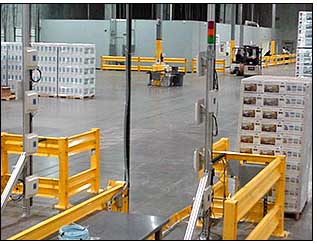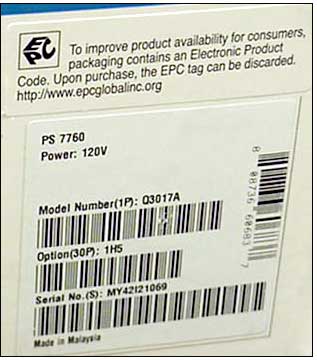More than two years ago, Hewlett-Packard, the IT and computer products and services provider based in Palo Alto, Calif., started deploying RFID in parts of its manufacturing and distribution chain. Now the company is using its experience and expertise to meet Wal-Mart’s mandate ahead of schedule. And in May, it launched a range of RFID services to help manufacturers and logistics companies ensure the effective selection, integration and deployment of the technology.
“We saw RFID as a way to help reduce manual processes and cut inventory,” says Salil Pradhan, chief technologist for HP’s RFID initiatives and a researcher at HP Labs. “Even before that we had seen the potential for RFID to combat counterfeiters in our ink cartridge business.” (Much of that work is still in its early stages, although before the end of the year, HP may step up its research in this area.)
“We see RFID as a business well worth our R&D investment, because it is a market that is set to see large growth,” says Pradhan. “We are investing our resources in the technology, as well as in providing consulting services worldwide. It is very, very important to our company.”
The company’s head start in deploying RFID is already paying dividends. HP is one of a handful of Wal-Mart suppliers tagging shipments to the retailer (see Wal-Mart Begins RFID Rollout). Currently, HP is placing RFID tags with Electronic Product Codes (EPCs) on two of its printers and one scanner; all told, it ships 65 consumer products to Wal-Mart. But HP says it will be ready to tag shipments of all its consumer products to Wal-Mart’s North Texas distribution center weeks ahead of the retailer’s January 2005 deadline.
So far, HP has designed and deployed RFID systems at two of its facilities in the United States (see HP Tags Printers, Scanners). At its Memphis manufacturing center, tags are placed on the packaging of each individually boxed desktop printer or scanner, and on the pallets on which the products are shipped. Before the tagged pallets are shipped to Wal-Mart, they are sent to an HP distribution center, where an RFID portal reads the tags to record the transfer of the finished goods. At its Chester, Va., plant, RFID tags are being placed on cases of HP inkjet printer cartridges that the company plans to ship to Wal-Mart.
HP is also preparing about 29 production facilities and distribution centers worldwide to handle EPC-tagged shipments. Its plants in Asia, which ship directly to Wal-Mart, are expected to be able to tag products before the end of the year.
HP maintains that what it has learned from these RFID deployments can be channeled into its efforts to support its customers RFID deployments. “We have a great deal of knowledge from deploying RFID in our own business,” says Pradhan. “First and foremost, we gained valuable knowledge about the physical level of RFID deployment: how and where do you tag things and what RFID products work well together and what do not.”
The company says it has also gained experience in deploying middleware and managing the exchange of RFID data in an enterprise. It has learned how much data RFID networks generate, what data to keep and how to store it.
“This is all experience we make available to our customers,” says Pradhan. “We are still learning, but what we have already learned helps us make sure the path for the customer is smoother.”
In addition to technical knowledge, HP has worked on ways to find and measure the return on investment, which HP believes is essential for any company deploying RFID. For example, in an initial proof-of-concept pilot at its Memphis location last year, the company measured that a pallet ready for shipment could be processed in just 11 seconds—well down from the 90 seconds it had taken previously.
“That was a specific process with a specific product,” says Ian Robertson, head of HP’s RFID program. “We know that in electronics manufacturing, there is a high degree of variability, and every item could mean a shift in configuration. But it made us think RFID was worth going after.”
HP has also gained experience in how to manage the personnel involved in an RFID deployment. “RFID deployment brings program management issues,” says Pradhan. “We have learned how to manage and organize an RFID team—sometimes across the world—to work toward meeting a mandate.”
Because RFID cuts across so many parts of HP’s business and operations, the company has developed a core RFID-deployment team that can work with any number of HP employees, depending on the project. “RFID is still an emerging technology, and it does not respect organizational boundaries,” says Pradhan. “We have one program throughout the company.”
HP’s core RFID team, composed of about 25 people, holds regular meetings and works with HP staff drawn from divisions throughout the company, including its enterprise group, internal supply chain group and HP labs. “We try to look at outstanding issues and what resolutions we reach,” says Pradhan. “There are also a lot technical and regulatory issues that need to be addressed. We also use meetings to remind people what we are working toward, where we are going in our own facilities.”
Several members of the RFID team sit on HP’s 12-person RFID governing council, which is responsible for the company’s strategy, direction and priorities for RFID initiatives. In addition to Robertson and Pradhan, members of the RFID council include Dick Lampman, director of research and HP’s representative on the board of EPCglobal, and Jim Milton, senior vice president customer solutions group and managing director of HP Americas.
HP applied what it learned from its own internal RFID deployments to develop and implement RFID projects for a number of Wal-Mart suppliers, including toy manufacturer Hasbro and Canadian fire-log company Conros. It took HP roughly 45 days to deploy a trial for Hasbro and around 60 days to design and complete the pilot for Conros (see link https://www.rfidjournal.com/article/view/1029 Log Maker Warms Up to RFID>). For the Conros pilot, HP worked with Matrics, which delivered the tags and reader infrastructure, Shipcom Wireless, which provided middleware to connect the system, and Conros’s own IT staff. Hasbro declined to release details of its project.
“We were able to duplicate a lot of what we had already learned with our own internal RFID deployments to deliver a turnkey solution to Conros,” says Victor Garcia, the managing principal for HP’s wireless and mobility program in Toronto.
HP has distilled its RFID experience into three RFID service offerings, which it launched in May (see HP Debuts RFID Services). For its entry-level offering, the RFID Discovery Service, HP brings customers to its own facilities where RFID has been deployed and to its RFID centers in Palo Alto or Taiwan, where it runs workshops to help customers become familiar with RFID technology. Customers can develop an understanding of how the technology could be implemented in their business, and they can use the center’s RFID equipment to run proof-of-concept tests for the items that they plan to tag. HP plans to open RFID centers in Singapore, Tokyo, Geneva and the United Kingdom.
HP’s second offering, the RFID Adaptive Starter Kit, is aimed at companies that want to proceed with an RFID pilot. The Starter Kit includes a selection of suitable tags and readers, as well as middleware that can be customized to each deployment. HP also provides guidance and training for the pilot.
HP’s RFID Readiness Assessment and Roadmap Planning service helps customers that have already completed RFID pilots develop and implement ways to connect their RFID deployments to their existing IT systems. The goal is to help companies find greater internal use RFID systems and potential benefits within their own operations. These internal benefits can offset the cost of tagging goods for a retail customer or the U.S. Department of Defense.
In addition to its three packaged services, HP can help its customers implement a full RFID deployment. HP maintains that it is flexible in how it develops RFID projects for its customers. “Some customers want us to be a one-stop shop, while others want to play a very active role in deciding which middleware, for example, that they want,” says Pradhan. HP’s pricing depends on the size of the pilot, ranging from a single portal to a whole warehouse.
HP is developing several RFID projects in its own facilities to increase its understanding of RFID and provide a clearer picture of what the technology can deliver to its customers. At HP’s Memphis facility, where one production line has been enabled to place RFID tags on products, the company is working to determine what problems might arise as that capability is deployed across the facility’s 21 other production lines and how much of what has been learned on the first line is applicable to the others.
HP Labs is planning an end-to-end RFID pilot involving the manufacturing and customer deployment of HP servers. The project will implement RFID technology for every stage of the process, from the creation of components that are used to make the servers all the way through to server deployment in a customer data center.
While HP says its RFID business will benefit from the experience, the company also believes its core server business will reap benefits. “With RFID used to ensure the correct manufacture of servers, we can make sure each configuration is correct before it is shipped,” says Pradhan. “There are very high costs for us when servers have to be returned, and those costs cut into profits.”
HP Labs is also developing a return-on-investment analysis model that it can share with customers, so they can see the financial benefits for deploying RFID at each stage of deployment. “Linking all suppliers in an adaptive supply chain with RFID is not going to happen overnight,” says Pradhan. “We have to show companies a way to invest enough [in RFID] to make progress but not too much to keep them from getting a real ROI.”
Further out, HP Labs would like to develop ways to supplement RFID systems in the supply chain by linking them with video so that items detected by RFID readers can be tracked across a large facility with a video camera. The use of a video system could eliminate the need for a large number of readers (see HP Designs Tracking System). The company is also looking at what it calls next-generation RFID, which will require a higher level of network resilience. “When whole world depends on RFID, there will be no room for failure,” says Pradhan. “RFID networks will have to be self-healing.




